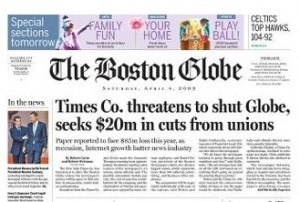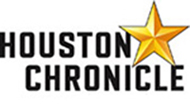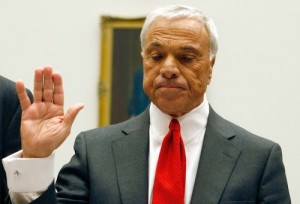 Two numbers stood out in Friday’s shocking news that the New York Times Co. was threatening to shut down the Boston Globe: $85 million and 450. The first number is the amount of money the Globe is expected to lose this year without union concessions. The second is the number of employees at the paper who have lifetime-employment contracts. All of those people should be very nervous right now.
Two numbers stood out in Friday’s shocking news that the New York Times Co. was threatening to shut down the Boston Globe: $85 million and 450. The first number is the amount of money the Globe is expected to lose this year without union concessions. The second is the number of employees at the paper who have lifetime-employment contracts. All of those people should be very nervous right now.
The Times Co., which is groaning under $1.1 billion in debt, wants the unions to give up $20 million in concessions or face closure of the 137-year-old Globe, which has dominated the news business in Boston for more than 30 years. Given the size of the projected loss this year, $20 million seems like a modest amount. This would indicate that the Times Co. threat is merely posturing, as Alan Mutter argues. But ultimatums appear to be working in San Francisco, where the union just voted 10-1 to give the Chronicle broad authority to lay off employees without regards to seniority as well as to cut vacation time and extend working hours. The Chronicle and the Globe have similar audience characteristics.
The brass ring for Times negotiators has to be the 450 Globe employees who work under lifetime job guarantees. We knew such guarantees existed, but we hadn’t seen a count of the number of employees who have them until this past Friday; they comprise nearly a third of the unionized workforce. It’s hard to imagine any company handing out promises of that kind, but the Globe did that in 1993, when the economy was emerging from recession and businesses were being conservative about guaranteeing anything. Such management hubris testifies to the dominance the Globe enjoyed at the time over the Boston market, where its only competition is the working-class Herald and a string of suburban dailies.
We live in Globe country and can testify to the paper’s reach in the affluent suburbs. Drive through a quiet subdivision on any Sunday morning and the Globe is the paper you see in the driveways of the $700,000 homes. However, the tech-savvy Boston audience is also more open than most to online alternatives, which is perhaps one reason Boston.com is the sixth largest newspaper website while the Globe reported a circulation decline of more than 10% last November on top of an 8.3% decline six months earlier.
If the 450 employees each cost $100,000 on a fully loaded basis, that’s $45 million in annual costs over which management effectively has no control. We don’t have to comment on the lack of motivation that guaranteed employment must instill in a heavily unionized environment. If we were Times Co. management, though, we’d probably aim the first few blows of the ax directly at that soft middle.
The Globe covers its own news with reaction from community members ranging from fry cooks to U.S. Senators.
College student Adam Sell, who has interned at the Globe for two years, sent us a link to a Flickr photostream he created of the closing of the Globe‘s NorthWest bureau 10 days ago.
Miscellany
Two central Pennsylvania newspapers that have published separately with a single weekly combined edition will join forces on a permanent basis at the end of June. The Intelligencer Journal and Lancaster New Era will be published Monday through Saturday mornings with combined news and features operations but separate editorial pages. The merger will result in the reduction of 60 full-time and 40 part-time positions, or about 20% of the workforce. Management said the combined circulation of 229,500 has been growing but that the economics of the publishing industry demands changes.
Publishers who are struggling with solutions to the revenue problem, none of them very appetizing, might want to look to Europe for inspiration. The big German publisher Axel Springer just reported record profits and is looking to expand overseas, possibly into the US. Norway’s VG Nett charges citizens for access to its news through a cable TV subscription fee. And a group of papers in Belgium joined forces to force Google to remove their content from its search results. All in all, some papers in Europe are doing just fine, thanks to tight government partnerships and creative approaches to revenue
 The Detroit Media Partnership, which publishes the Detroit Free Press and the Detroit News, has closed a deal with Plastic Logic to distribute the Plastic Logic Reader under purchase or lease to subscribers of the Detroit dailies as an alternative to paper delivery. The reader is the size of an 8.5 x 11-in. pad of paper, weighs less than many print magazines and sports a touch-screen interface.
The Detroit Media Partnership, which publishes the Detroit Free Press and the Detroit News, has closed a deal with Plastic Logic to distribute the Plastic Logic Reader under purchase or lease to subscribers of the Detroit dailies as an alternative to paper delivery. The reader is the size of an 8.5 x 11-in. pad of paper, weighs less than many print magazines and sports a touch-screen interface.
With the Minneapolis Star Tribune in bankruptcy, employees have started a grass-roots effort to save the paper. A group has launched a Facebook group (1,280 members, but only one discussion post since Jan. 17), a website (inactive as of this morning) and plans to hand out paper hats and scorecards at the Twins’ home opener. It’s probably going to take more than that.
If you like Chicago Sun-Times columnist Richard Roeper, you probably won’t after reading this egotistical, self-indulgent monument to himself. If this is how newspaper columnists regard their own celebrity, it’s no surprise readers are turning elsewhere. But there are a couple of good anecdotes that illustrate how divorced these scribes are from their readers.
Google CEO Eric Schmidt will keynote the Newspaper Association of America national convention in San Diego this week. Schmidt, who is often considered the great Satan by newspaper publishers, has nevertheless been a vocal proponent of the need to help the industry. It should be an interesting encounter. Schmidt is scheduled to speak on Tuesday at 10 a.m. PDT. You can listen to his remarks live. NAA will offer a moderated “Cover it Live” discussion on its PressimeNow! blog, where visitors can pose questions, share their thoughts and get live reactions from attendees.
The Sun-Times Media Group is considering ending publication of some of its suburban newspapers as it struggles to emerge from its recently declared bankruptcy.
A.H. Belo Corp., owner of the Dallas Morning News and three other daily newspapers, will cut employee salaries next month and suspend a retirement supplement to pension plan participants next year. Cuts will range from 2.5% to 15%, depending on an employee’s salary. The company’s CEO will also take a 20% cut in pay.
Last month we told you about St. Louis Post-Dispatch editor Christopher Ave’s use of song to lament the layoffs of newspaper copy editors. Now, 26-year old Berkeley musician named Jonathan Mann has joined forces with the staff of the East Bay Express to come up with a solution to newspapers’ business problems. You have to wait to the end to hear it, but the three minutes are time well spent.


 The Houston Chronicle joins the long string of newspapers that assert their commitment to “strong watchdog journalism” while covering news of their own troubles with e.e. cummings-like simplicity. The newspaper devotes just 208 words to news that it is laying off 12% of its staff, or nearly 200 people. That’s about one word per victim. In fact, the Chronicle doesn’t even mention a body count. You have to
The Houston Chronicle joins the long string of newspapers that assert their commitment to “strong watchdog journalism” while covering news of their own troubles with e.e. cummings-like simplicity. The newspaper devotes just 208 words to news that it is laying off 12% of its staff, or nearly 200 people. That’s about one word per victim. In fact, the Chronicle doesn’t even mention a body count. You have to 




 Today is Newspaper Death Watch’s second birthday (you can
Today is Newspaper Death Watch’s second birthday (you can 









